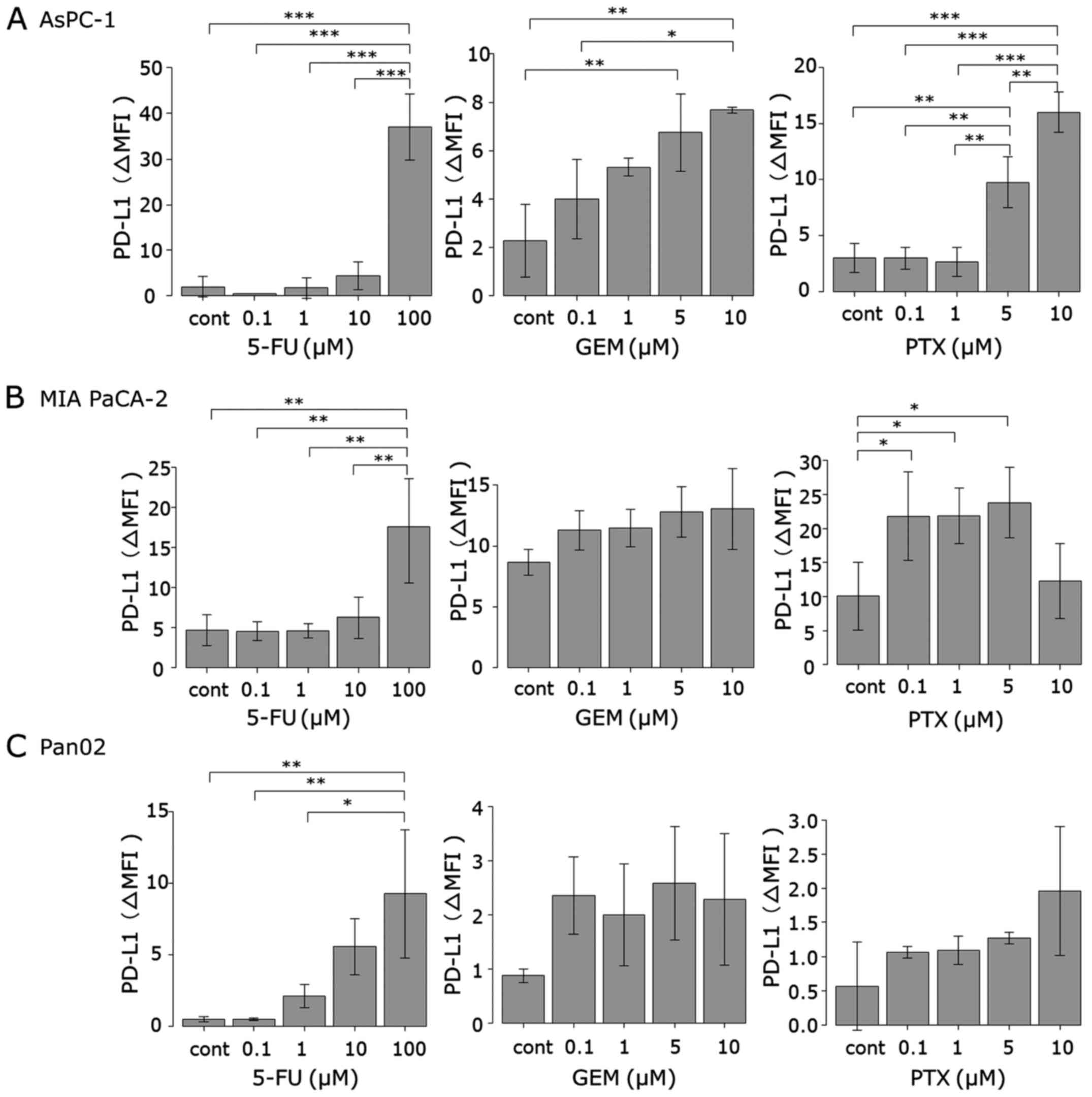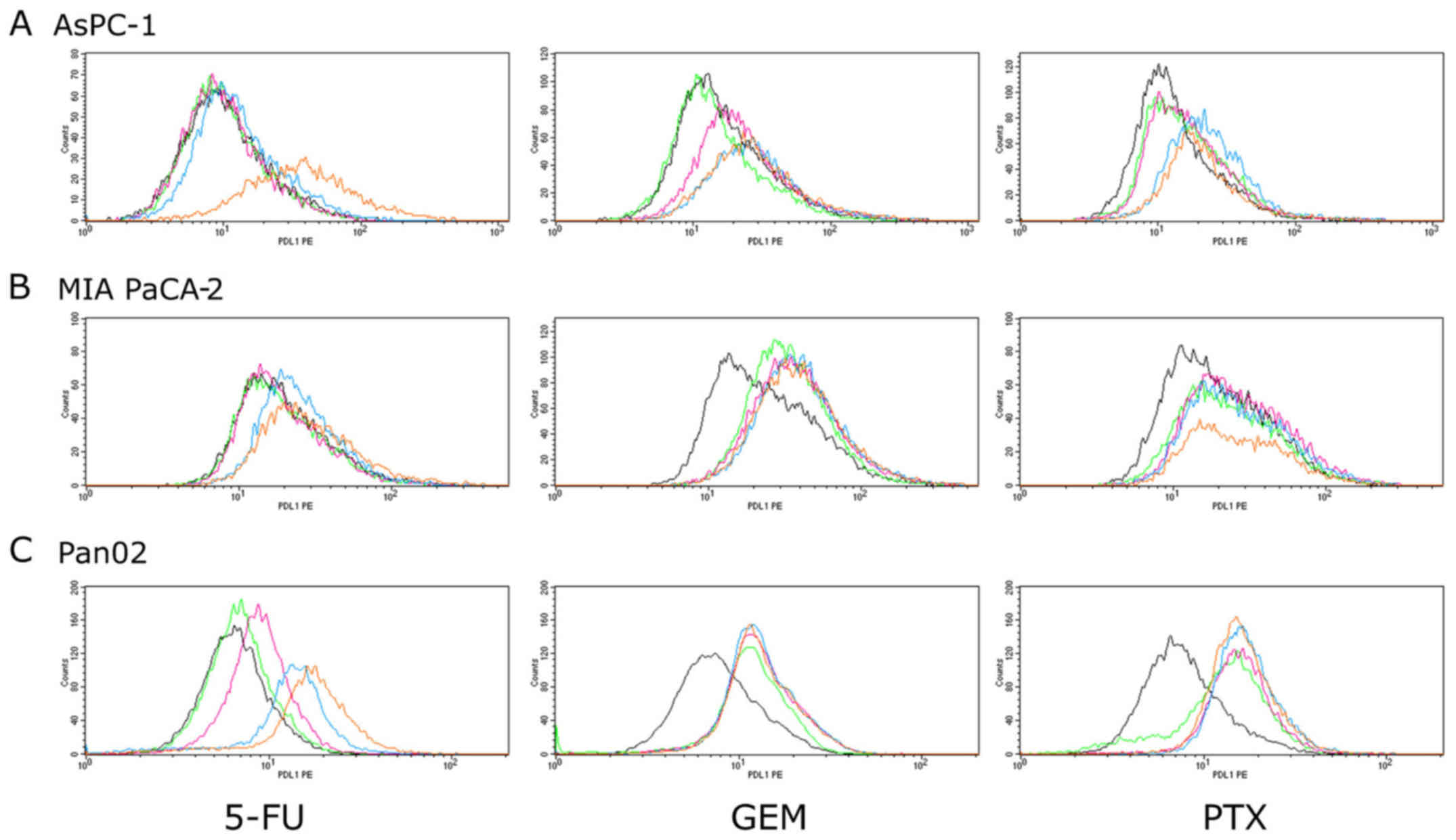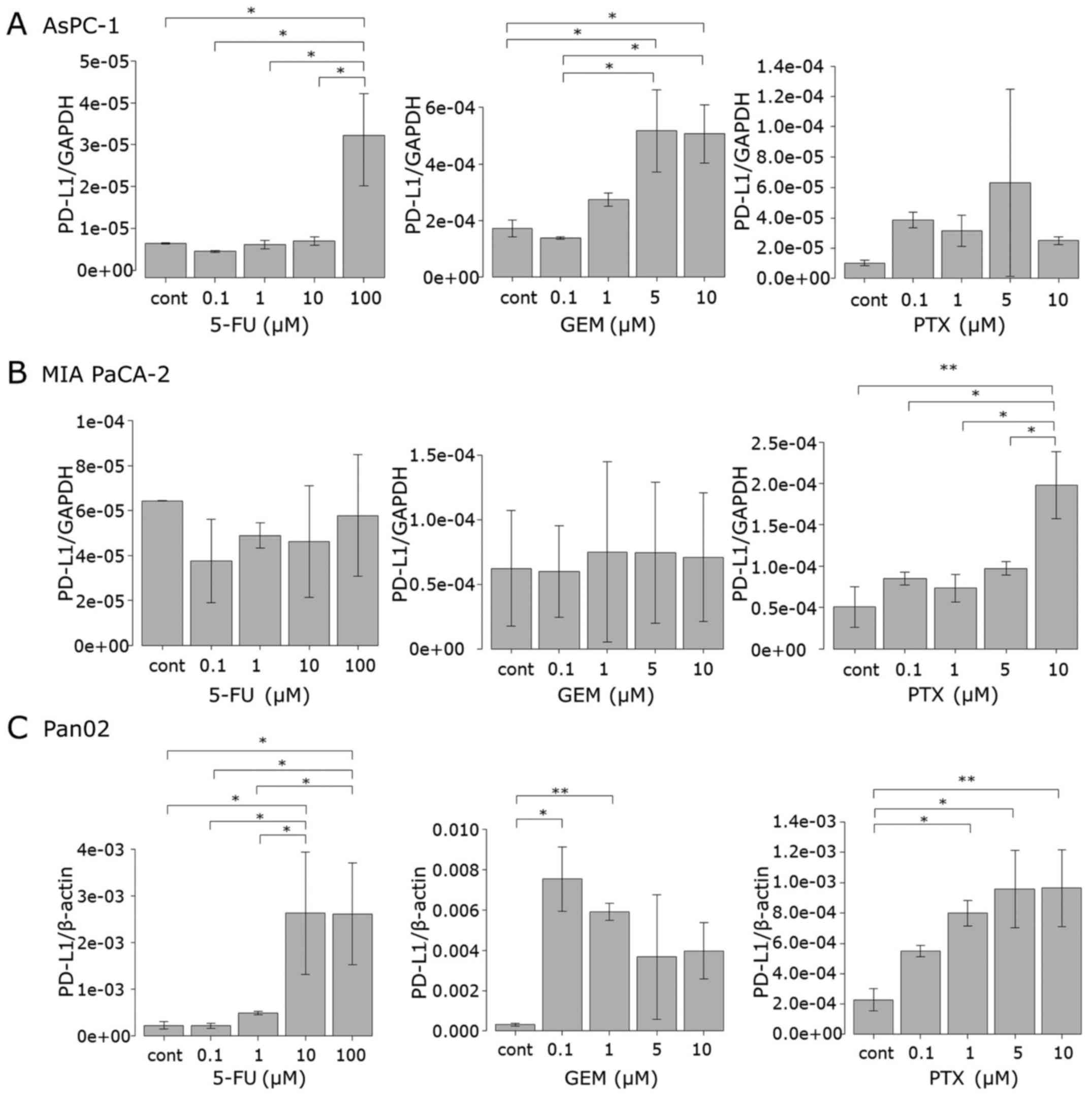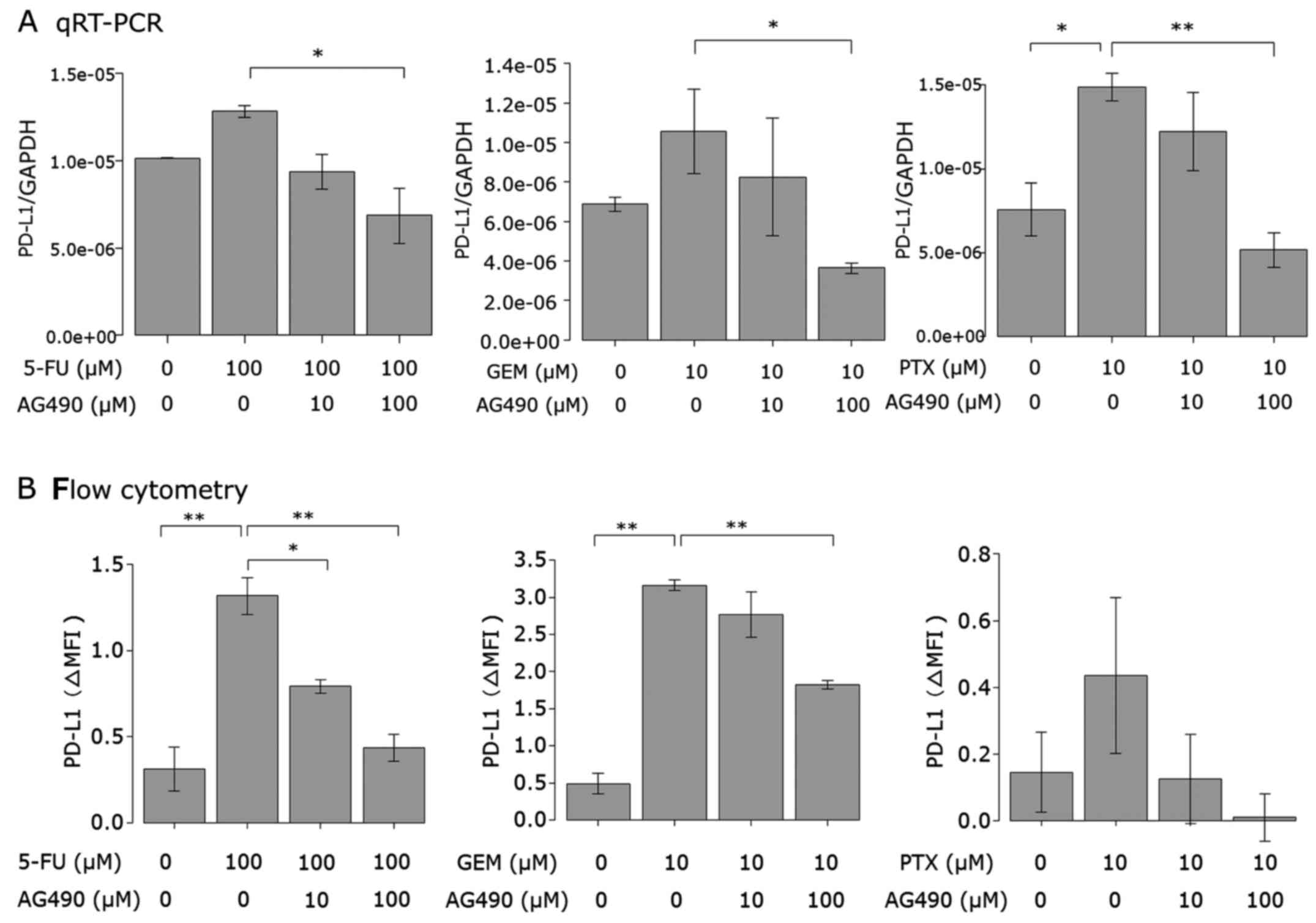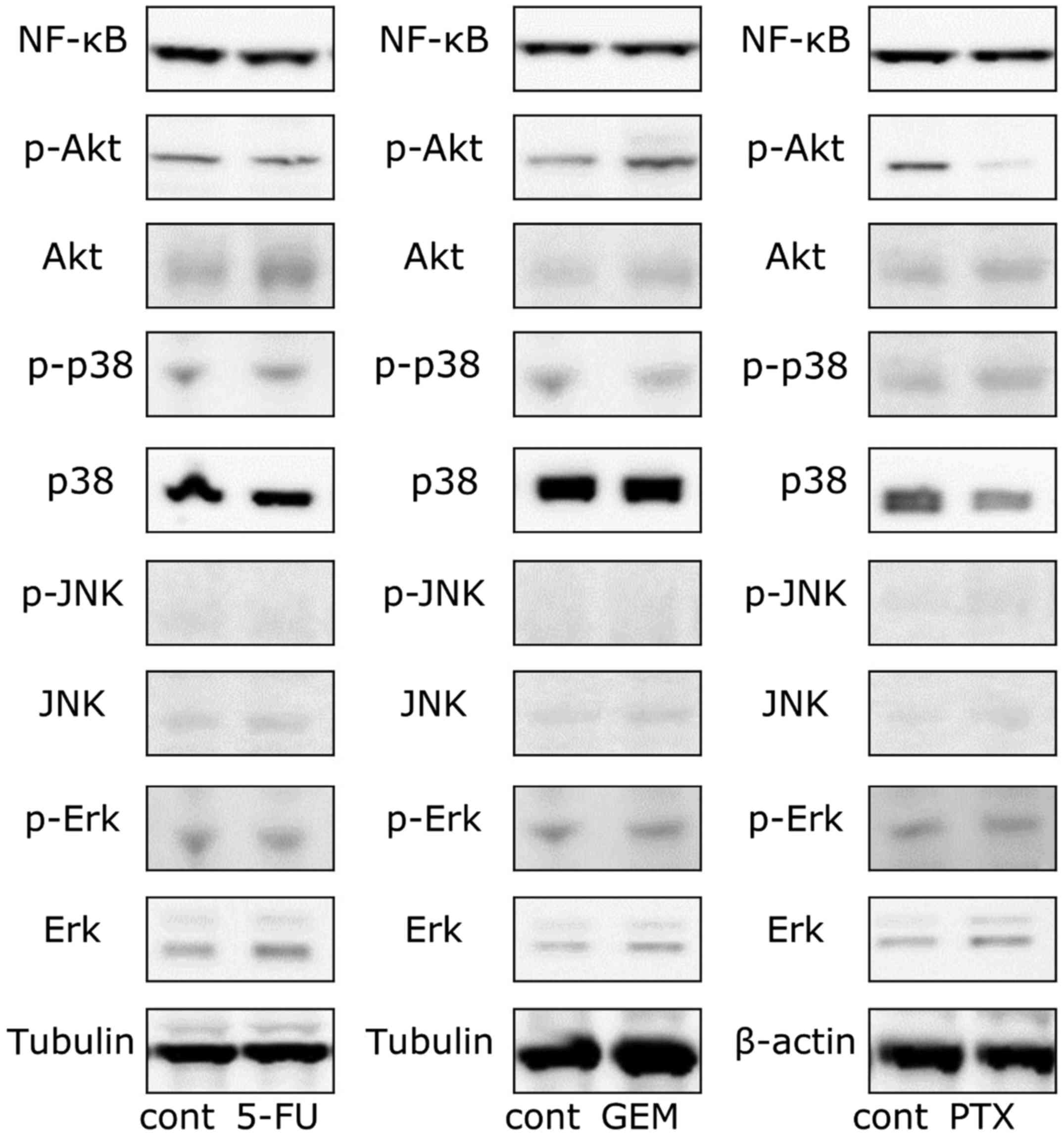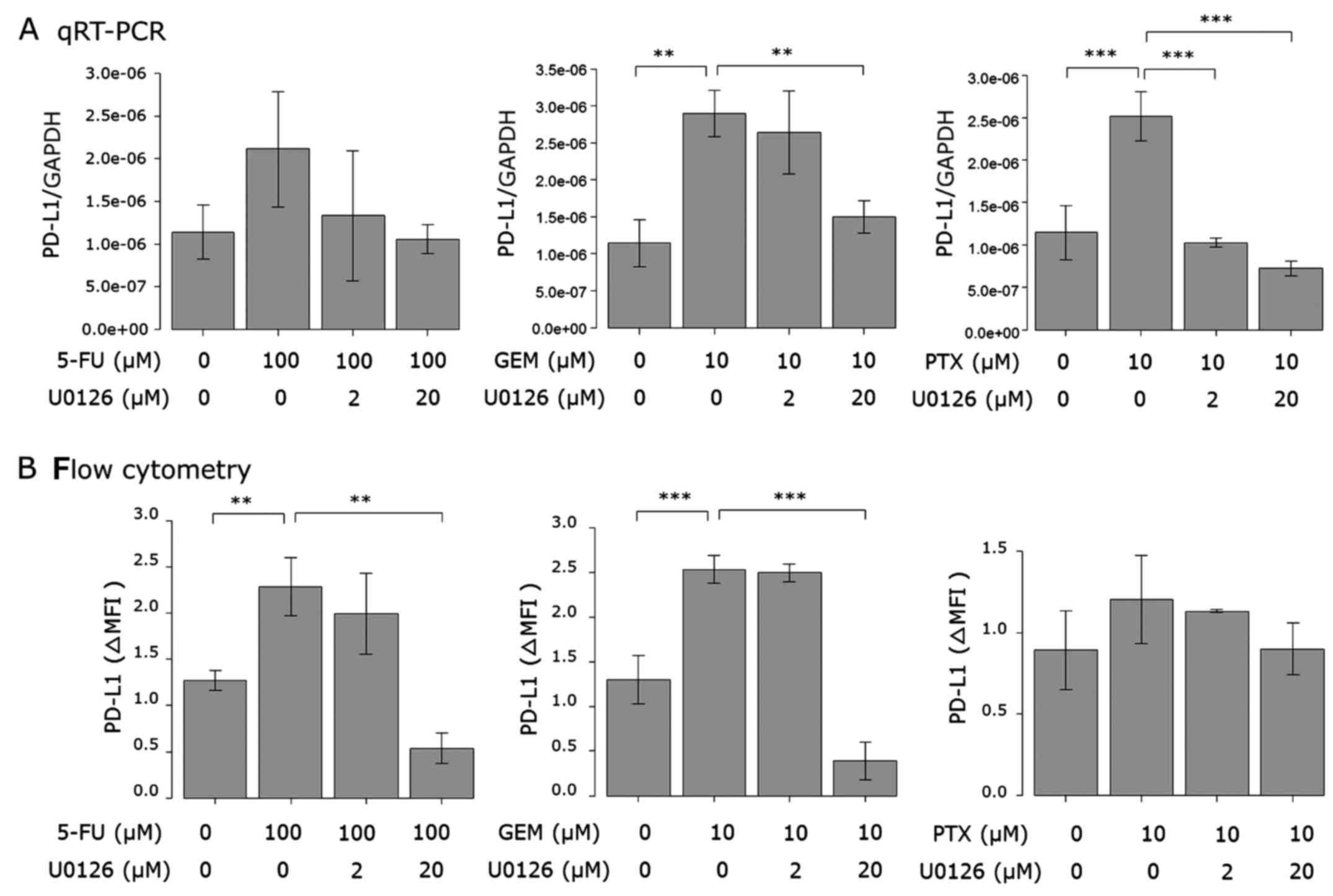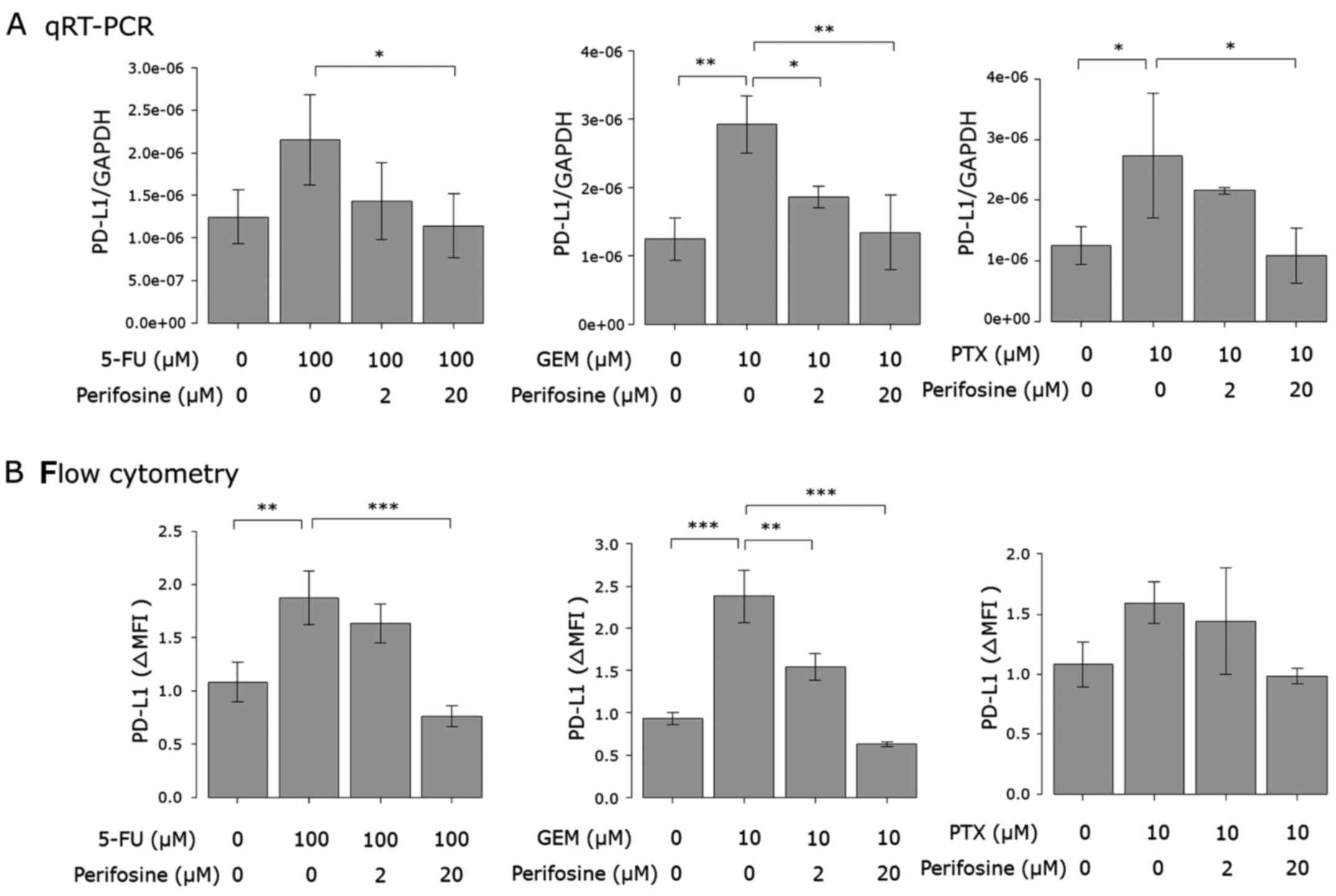The JAK/STAT pathway is involved in the upregulation of PD-L1 expression in pancreatic cancer cell lines
- Authors:
- Published online on: January 23, 2017 https://doi.org/10.3892/or.2017.5399
- Pages: 1545-1554
Abstract
Introduction
Pancreatic cancer is the fourth leading cause of cancer-related deaths in Japan (1) and the USA (2). This cancer is highly resistant to systemic therapies and this is partially the reason for its high mortality rate (3,4). Gemcitabine chemotherapy has been the standard treatment for pancreatic cancer for about a decade; however, gemcitabine plus nanoparticle albumin-bound (nab)-paclitaxel and FOLFIRINOX (5-fluorouracil, oxaliplatin, irinotecan and leucovorin) were found to result in better overall survival (OS) and is now commonly used (5,6). The drawback however is that these regimens are more toxic than gemcitabine monotherapy. Moreover, despite the improvements in chemotherapy, OS is still less than one year. Therefore, more effective and better-tolerated treatment options are required to improve the outcome for patients with advanced pancreatic cancer.
Exciting progress has been made in cancer immunotherapy with breakthrough immune checkpoint inhibitors and new cell therapies that enhance the effectiveness of T cells (7). Programmed death-1 (PD-1) found on activated T cells is a member of the CD28 family, and is a key immune checkpoint molecule. When PD-1 binds to programmed death-ligand 1 (PD-L1) or PD-L2, the T cell receives an inhibitory signal and no longer mounts productive immune responses (8,9). Nivolumab, a fully human IgG4 PD-1 antibody, restores anticancer immune responses by abrogating PD-1 pathway-mediated T cell inhibition and has been approved for use in Japan and the USA for treating patients with unresectable melanoma (9,10). The clinical efficacy of nivolumab has also been reported in patients with non-small cell lung cancer (11) and renal cell carcinoma (12). In addition to PD-1 and PD-L1, other immune checkpoint inhibitors are currently being developed for various tumors (13,14).
PD-1 or PD-L1 antibodies have been shown to exert a substantial antitumor effect in mouse pancreatic cancer models (15,16). Although no studies to date have demonstrated the clinical efficacy of immune checkpoint inhibitor monotherapy for pancreatic cancer (17,18), ipilimumab (a checkpoint inhibitor of CTLA-4) combined with cancer vaccine has shown a survival benefit (19,20). Thus, immune checkpoint inhibitors combined with immune- or non-immune-based therapies are great prospective treatment strategies for pancreatic cancer.
It is still unclear what impact anticancer agents have on immune checkpoint molecules when chemotherapy is combined with immunotherapy. Very few studies have addressed the PD-1/PD-L1 pathways, and there are contradictions among them (21–24). It is within this context that we investigated how anticancer agents influence PD-L1 expression in pancreatic cancer cell lines. In the present study, we demonstrated that commonly used anticancer agents for pancreatic cancer (i.e. gemcitabine, 5-fluorouracil and paclitaxel) upregulate cell surface PD-L1 expression in both human and mouse pancreatic cancer cell lines. Additionally, we provide evidence that not only the MAPK and PI3K/AKT pathway, which are known pathways, but also the JAK/STAT pathway is involved in the induction of PD-L1 expression in response to these anticancer agents.
Materials and methods
Cell lines and reagents
The human pancreatic cancer cell line MIA PaCa-2 was obtained from Riken BioResource Center (Tsukuba, Japan) and AsPC-1 cells were obtained from the American Type Culture Collection (ATCC; Rockville, MD, USA). The murine pancreatic cancer cell line Pan02, which is syngeneic to C57Bl/6 mice, was purchased from the Division of Cancer Treatment and Diagnosis, National Cancer Institute (Bethesda, MD, USA). AsPC-1 and Pan02 cells were grown in 75 cm2 cell culture flasks and maintained in Roswell Park Memorial Institute (RPMI)-1640 medium supplemented with 10% fetal bovine serum (FBS), L-glutamine and penicillin (100 U/ml)/streptomycin (100 µg/ml) (both from Gibco Life Technologies, Carlsbad, CA, USA). MIA PaCa-2 cells were cultured in Dulbecco's modified Eagles medium low glucose supplemented with 10% FBS, L-glutamine and penicillin (100 U/ml)/streptomycin (2.5 µg/ml). Cells were incubated at 37̊C in a humidified atmosphere containing 5% CO2.
In the present study, we used gemcitabine (GEM), 5-fluorouracil (5-FU) and paclitaxel (PTX) which are agents commonly used to treat pancreatic cancer; all agents were immediately prepared before use. GEM was purchased from the Tokyo Chemical Industry Co., Ltd. (Tokyo, Japan), 5-FU from Kyowa Hakko Kirin Co., Ltd. (Tokyo, Japan) and PTX was obtained from Nippon Kayaku Co., Ltd. (Tokyo, Japan).
Evaluation of PD-L1 expression after exposure to anticancer agents
Cells were seeded at 3.0–4.5×105 cells/well in 6-well plates 48 h before treatment and left to incubate at 37̊C in a humidified atmosphere containing 5% CO2. After 48 h, cells were exposed to various concentrations of GEM, 5-FU and PTX for 6–72 h. For each drug, the concentration used in our experiment was based on their plasma level in clinical use. The expression level of PD-L1 was determined using flow cytometry and qRT-PCR.
Treatment with JAK/STAT and other pathway inhibitors
AsPC-1 cells were adjusted to 4.5×105 cells/well into 6-well plates. After a 48-h incubation at 37̊C in a humidified atmosphere containing 5% CO2, the cells were treated for 1 h with various concentrations of JAK2 (AG490; Santa Cruz Biotechnology, Inc., Dallas, TX, USA), Akt (perifosine) or MEK1/2 inhibitors (U012) (both from Cell Signaling Technology, Inc., Danvers, MA, USA). Cells were stimulated with 5-FU, PTX and GEM and then incubated in the presence or absence of AG490 for an additional 6–48 h. PD-L1 expression was analyzed using flow cytometry and qRT-PCR.
Western blotting
Cells were washed twice with phosphate-buffered saline (PBS) and lysed in ice-cold lysis buffer (CelLytic™ MT cell lysis reagent) containing 2% proteinase inhibitor (both from Sigma-Aldrich Co., St. Louis, MO, USA). Cells were retrieved with a cell scraper, stirred and incubated on ice for 15 min. Lysates were centrifuged, supernatants were collected, and protein concentration was determined using the Bio-Rad protein assay (Bio-Rad Laboratories, Hercules, CA, USA). The supernatants were diluted with NuPAGE LDS sample buffer (Life Technologies, Grand Island, NY, USA) to create equal concentrations of protein. Ten micrograms of protein were separated on 4–12% NuPage Bis-Tris gels and blotted onto a nitrocellulose membrane using the iBlot Dry Blotting System (all from Life Technologies) according to the manufacturer's protocol. Blots were blocked with 10% EzBlock Chemi (ATTO Corporation, Tokyo, Japan) in TBS-T [10 mM Tris-HCl (pH 8.0), 150 mM NaCl, 0.1% Tween-20 v/v] for 1 h at room temperature and washed with TBS-T 3 times. The membranes were incubated overnight at 4̊C with anti-STAT1, anti-phospho-STAT1, anti-NF-κB (all from Cell Signaling Technology, Inc.), anti-Akt1/2/3, anti-phospho-Akt1/2/3, anti-p38, anti-phospho-p38 (all from Santa Cruz Biotechnology, Inc.), anti-JNK (Cell Signaling Technology, Inc.), anti-phospho-JNK (Santa Cruz Biotechnology, Inc.), anti-Erk 1/2 (Cell Signaling Technology, Inc.), anti-phospho-Erk 1/2, anti-tubulin (both from Santa Cruz Biotechnology, Inc.) and anti-β actin (Abcam, Cambridge, MA, USA) antibodies in TBS-T (diluted 1:1,000). After washing in TBS-T, the membranes were incubated with the secondary anti-rabbit and mouse IgG antibodies (Life Technologies) in TBS-T (diluted 1:10,000) for 1 h at room temperature. Immunocomplexes were detected using western blotting (ECL Prime; GE Healthcare UK Ltd., Buckinghamshire, UK).
Quantitative reverse transcription-polymerase chain reaction (qRT-PCR)
The expression level of PD-L1 was determined using real-time PCR as previously described (25). The samples used for mRNA isolation were removed from the pancreatic cancer cells (AsPC-1, MIA PaCa-2 and Pan02). Total mRNA was extracted using the acid guanidinium phenol chloroform method with Isogen (Nippon Gen Co. Ltd., Tokyo, Japan). The isolated RNA was stored at −80°C until use for real-time PCR. In the latter, 1 µg of extracted RNA was reverse-transcribed. The resulting cDNA was subjected to qRT-PCR using the following primers for human PD-L1: (forward primer, 5′-GTACCGCTGCATGATCAGCTAT-3′ and reverse primer, 5′-GGCATTGACTTTCACAGTAATTCG-3′); murine PD-L1 (forward primer, 5′-CAGGCCGAGGGTTATCCA-3′ and reverse primer, 5′-CGGGTTGGTGGTCACTGTTT-3′); human GAPDH (forward primer, 5′-ACCACAGTCCATGCCATCACT-3′ and reverse primer, CCATCACGCCACAGTTT CC); and murine β-actin (forward primer, 5′-TATCCACCTTCCAGCAGATGT-3′ and reverse primer, 5′-AGCTCAGTAACAGTCCGCCTA-3′). PCR was performed using a Power SYBR-Green PCR Master Mix and a real-time PCR system (7300; Applied Biosystems, Foster City, CA, USA). Relative quantifications of gene expression with qRT-PCR data were calculated relative to human GAPDH or murine β-actin.
Flow cytometric analysis
PD-L1 surface expression was analyzed by flow cytometry. Cells harvested from in vitro cultures were washed twice with CellWash™ (Becton-Dickinson and Co., Franklin Lakes, NJ, USA) and then incubated with anti-PD-L1 (human, Becton-Dickinson and Co., mouse, eBioscience, San Diego, CA, USA); or isotype control antibodies (eBioscience) for 30 min at 4̊C. The cells were washed with CellWash once and analyzed by flow cytometer on a FACSCalibur flow cytometer and CellQuest™ Pro version 6.0 software (both from Becton-Dickinson and Co.).
Statistical analysis
Results are expressed as means ± standard error of the mean (SEM). Comparisons among groups or against one control group were evaluated by one-way ANOVA test followed by the Tukey-Kramer's or Dunnett's post hoc multiple comparisons test, respectively. Statistical significance was taken as P<0.05. Statistical analyses were performed with EZR (Saitama Medical Center, Jichi Medical University, Saitama, Japan), which is a graphical user interface for R (The R Foundation for Statistical Computing, Vienna, Austria). More precisely, it is a modified version of R commander designed to add statistical functions frequently used in biostatistics (26).
Results
Anticancer agents upregulate PD-L1 surface expression in pancreatic cancer cell lines
MIA PaCa-2, AsPC-1 and Pan02 cells were treated with GEM, 5-FU and PTX for 24–72 h to determine whether they can induce PD-L1 protein expression. Expression was determined using flow cytometry and is expressed as the Δ mean fluorescence intensity (ΔMFI; MFI using anti-PD-L1 subtracted from the isotype control). As shown in Figs. 1 and 2, treatment with 5-FU for 72 h induced PD-L1 surface expression in both human pancreatic cancer cell lines (MIA PaCa-2 and AsPC-1) at 100 µM, whereas 5-FU did not affect the expression at concentrations <100 µM. In mouse pancreatic cancer cell line Pan02, 5-FU (72 h) at concentrations >1 µM induced PD-L1 expression in a dose-dependent manner. Treatment with GEM for 24 h induced PD-L1 expression in the AsPC-1 cells in a dose-dependent manner. In both MIA PaCa-2 and Pan02 cell lines, GEM induced PD-L1 expression at each concentration, but it did not reach statistical significance. Treatment with PTX for 48 h significantly induced PD-L1 expression in the AsPC-1 cells at concentrations of 5 and 10 µM and in MIA PaCa-2 cells at each concentration except 10 µM. PTX also induced PD-L1 expression in mouse Pan02 cells at each concentration, but it did not reach statistical significance.
Anticancer agents induce PD-L1 mRNA expression in pancreatic cancer cell lines
To investigate how the anticancer agents induce PD-L1 protein expression in tumor cells, the mRNA level of PD-L1 was determined by qRT-PCR. MIA PaCa-2, AsPC-1 and Pan02 cells were treated with 5-FU, GEM and PTX for 24 h in a manner similar as that carried out for the protein assessment as described above. In AsPC-1 cells, 5-FU significantly increased the PD-L1 mRNA level at 100 µM, as observed in the surface protein expression. Treatment with GEM at 5 and 10 µM significantly upregulated mRNA expression while each dose of PTX upregulated mRNA expression although not to statistically significant levels (Fig. 3A). In the MIA PaCa-2 cells, neither 5-FU nor GEM affected PD-L1 mRNA expression, whereas PTX at 10 µM significantly increased the mRNA level (Fig. 3B). The PD-L1 mRNA expression pattern in the Pan02 cells was similar to that of the surface protein, that is, the mRNA level increased when 5-FU exceeded 1 µM, while GEM and PTX upregulated the mRNA level at each concentration (Fig. 3C).
Anticancer agents activate the JAK/STAT pathway
The protein and mRNA expression analyses suggest that surface PD-L1 protein expression in the AsPC-1 and Pan02 cells was regulated mainly at the mRNA level. As such, we used the human AsPC-1 cell line to ascertain the molecular mechanisms by which the anticancer agents induced PD-L1 mRNA expression. It has been reported that the JAK/STAT pathway is deeply involved in IFN-γ-mediated PD-L1 upregulation in solid tumors such as lung cancer and hepatocellular carcinoma (27,28). In contrast, this pathway has not been implicated in anticancer agent-mediated PD-L1 expression. As such, we aimed to ascertain whether our three anticancer agents activate the JAK/STAT signaling pathway in AsPC-1 cells. AsPC-1 cells were exposed to 5-FU (100 µM) or GEM (10 µM) for 48 h, and PTX (10 µM) for 24 h following which the expression level and phosphorylation of STAT1 were determined using western blotting. The phosphorylation of STAT1 was greatly induced by each of the three anticancer agents (Fig. 4). The protein level of STAT1 was increased after 5-FU and GEM treatment, whereas it remained unchanged after PTX treatment.
Anticancer agent-induced PD-L1 expression is attenuated by blocking the JAK/STAT pathway
Next, we examined the effect of a JAK2 inhibitor on the upregulation of PD-L1 expression induced by the anticancer agents in AsPC-1 cells. Cells were treated with the JAK2 inhibitor AG490 or left untreated prior to 5-FU, PTX or GEM stimulation. Both PD-L1 mRNA expression (Fig. 5A) and cell surface protein (Fig. 5B) induced by the anticancer agents were attenuated by AG490 in a dose-dependent manner. AG490 at 100 µM almost completely attenuated the PD-L1 expression induced by the anticancer agents.
Involvement of other pathways
Additionally, we also investigated whether the PI3K/AKT (29), NF-κB (24,30) and MAPK (23,31) pathways respond to anticancer agents, since they were previously implicated in anticancer agent-induced PD-L1 expression. The phosphorylation of Akt was induced by only GEM stimulation, although its protein level was enhanced by 5-FU and GEM (Fig. 6). The protein level of Erk was enhanced by each of the three anticancer agents. The intracellular protein level of NF-κB and the phosphorylation and protein levels of p38 were not affected by the drugs (Fig. 6). Considering the results of the western blot analysis, we also investigated the effect of the inhibitors of the PI3K/AKT and MAPK pathways. As shown in Figs. 7 and 8, anticancer agent-induced PD-L1 upregulation was attenuated by the Akt and MEK1/2 inhibitors.
Discussion
The success of immune checkpoint inhibitors and new generations of adoptive cell transfer therapy, such as chimeric antigen receptor (CAR) T cell therapy, have highlighted the potential of immunotherapy as a treatment option for various tumors (7,32). Moreover, extensive effort is being directed toward effectively combining immune- and non-immune-based therapies. For example, combining immune therapy and anticancer agents is being explored, albeit the impact of anticancer agents on the expression of immune checkpoint molecules is not yet fully understood. In the present study, we present two major findings. Firstly, PD-L1 surface expression in pancreatic cancer cell lines was upregulated by 5-fluorouracil, paclitaxel and gemcitabine. Secondly, the JAK/STAT pathway as well as other known pathways (i.e. MAPK and PI3K pathway) were involved in this PD-L1 upregulation. To the best of our knowledge, this is the first study to address the effect of anticancer agents on PD-L1 expression in pancreatic cancer cells and the involvement of the JAK/STAT pathway in the anticancer agent-mediated PD-L1 expression.
The effect of chemotherapy agents on PD-L1 expression has been discussed in four studies that we are aware of. However, there is a lack of consensus and the topic remains controversial (21–24). Among them, three studies demonstrated that the anticancer agents upregulated surface PD-L1 expression, while the fourth reported the downregulation of surface PD-L1. In their study, Zhang et al observed that paclitaxel, etoposide and 5-fluorouracil induced PD-L1 surface expression in human breast cancer cell lines (21), however they did not study the molecular mechanisms that led to the increase in PD-L1 expression. Gong et al reported that paclitaxel induced PD-L1 surface protein and mRNA expression in both human colorectal (SW480) and human hepatocellular carcinoma (HepG2) cell lines (23). They demonstrated that paclitaxel treatment induced Erk 1/2 phosphorylation in both cell lines and the increase in PD-L1 expression caused by paclitaxel was partially blocked by an MEK inhibitor. Peng reported that PD-L1 expression in ovarian cancer cell lines was augmented via NF-κB signaling by paclitaxel, gemcitabine or carboplatin treatment (24). In contrast, Ghebeh et al reported that doxorubicin downregulated the surface expression of PD-L1 in breast cancer cells and upregulated nuclear expression of PD-L1 by means of the PI3K/AKT pathway (22). One possible explanation for the difference among these four studies, as well as our own, may be attributed to differences in the cell lines and anticancer agents used in each study. In the present study, we used 5-fluorouracil, gemcitabine and paclitaxel since they are commonly used alone or combined with other agents when treating pancreatic cancer. The concentration of each anticancer agent in our experiments was based on the plasma level of each drug when clinically used (33,34) or the concentration that was used in previous in vitro experiments (21,35,36). Consequently, the maximum concentration of 5-fluorouracil in our experiment was 10-fold higher than that used for gemcitabine and paclitaxel. This difference in drug concentration among the anticancer agents may have influenced the degree of PD-L1 induction by the agents.
In the present study, PD-L1 surface protein expression was enhanced in all pancreatic cancer cell lines. The absolute value of PD-L1 expression determined by flow cytometry or qRT-PCR varied with each experiment; this could partly result from PD-L1 expression being affected by cell conditions. PD-L1 expression was consistently upregulated when stimulated by the anticancer agents; the pattern of this relative change was identical in each experiment. We observed that PD-L1 at the mRNA level was upregulated as well as surface protein expression when AsPC-1 or Pan02 cells were stimulated by each anticancer agent. Meanwhile, the mRNA level of PD-L1 in the MIA PaCa-2 cells did not increase when cells were treated with 5-fluorouracil, gemcitabine or lower concentrations of paclitaxel. It was reported that doxorubicin alters PD-L1 surface expression by a post-transcriptional regulation mechanism that involves the translocation of the protein from the membrane to the nucleus (22). Since anticancer agents induced PD-L1 surface protein expression without upregulating mRNA in the MIA PaCa-2 cells, it is possible that the expression was mainly regulated at a post-transcriptional level in this cell line.
In regards to the mechanism of PD-L1 regulation, Pardoll reported that innate and adaptive immune resistance are the two general mechanisms by which tumor cells regulate PD-L1 (37). In innate immune resistance, PD-L1 expression is driven by constitutive oncogenic signaling pathways such as the PI3K/AKT pathway (38) and STAT3 (39). In contrast, in adoptive immune resistance, several signaling pathways such as JAK/STAT (27,28), PI3K (29), MAPK (29) and NF-κB (29,30) appear to be involved in PD-L1 expression induced by IFN-γ. Only the PI3K/AKT (22), MAPK (23) and NF-κB (24) pathways have been previously reported to be involved in the upregulation of PD-L1 induced by anticancer agents, but involvement of the JAK/STAT pathway has not yet been reported. To obtain a better understanding of the mechanisms involved in PD-L1 upregulation, we sought to determine whether the JAK/STAT pathway regulates PD-L1 transcription. We found that each of the three anticancer agents induced the phosphorylation of STAT1 in the AsPC-1 cells, and JAK2 inhibitor AG490 reversed the upregulation of PD-L1 induced by the anticancer agents at both the mRNA and protein levels. These findings indicate that the JAK/STAT pathway regulates the expression of PD-L1. Other previously reported signaling pathways (i.e. MAPK and PI3K pathways) are also implicated in the present study. The relative importance of these pathways is unknown at the present, but we believe that these pathways are intricately involved in the anticancer agent-mediated PD-L1 expression by signaling crosstalk.
The discoveries made in the present study are a critical step towards further uncovering the mechanism of PD-L1 expression in pancreatic cell lines albeit with a few limitations. In the present study, we examined the signaling pathways in AsPC-1 cells only, therefore it is unclear whether these results apply to other cell lines. Pancreatic cancer cell lines including AsPC-1 and MIA PaCa-2 have different genetic alterations such as the KRAS (v-Ki-ras2 Kirsten rat sarcoma viral oncogene homolog), TP53 (encoding the p53 protein) and SMAD4 (SMAD family member 4, also known as DPC4; deleted in pancreatic carcinoma locus 4) gene mutations, which affect growth characteristics, tumorigenicity and chemosensitivity (40). AsPC-1 is considered more resistant to gemcitabine than MIA PaCa-2 (40,41). Gemcitabine resistance has been liked to signaling pathways associated with PD-L1 expression such as JAK/STAT, MAPK, PI3K-AKT and NF-κB (42–45). These genetic alterations and the difference in the cell signaling response to anticancer agents can also alter the PD-L1 expression induced by the anticancer agents. Future research using additional cell lines is needed to clarify the relationship between these genotypic differences among cell lines and their effect on the PD-L1 expression induced by anticancer agents.
In conclusion, our results indicate that 5-fluorouracil, gemcitabine and paclitaxel enhance PD-L1 expression in pancreatic cancer cell lines via several pathways including the JAK/STAT pathway. Pancreatic cancer is still intractable due to its resistance to conventional treatments including anticancer agents. Our results imply that anticancer agents not only cause cytotoxicity, but also alter the tumor immune response which may induce tumor immune escape. Cancer immunotherapy including blockade of PD-1/PD-L1 is expected to become the new standard therapy for many cancers and combination strategy in immunotherapy is currently being developed. We believe that the data provided in the present study, may aid in the design of more effective treatments that combine chemotherapy and immunotherapy.
Acknowledgements
The present study was supported by Grant-in-Aid for Scientific Research (C) to T.I. (no. 26460914) and Grant-in-Aid for Young Scientist (B) to T.O. (no. 26830112) from the Ministry of Education, Culture, Sports, Science and Technology of Japan. Yoshito Itoh received a lecture fee and is affiliated with a department that was partially funded by Bristol-Myers Squibb, and receives a grant from Kyowa Hakko Kirin Co. Ltd.
Glossary
Abbreviations
Abbreviations:
|
PD-1 |
programmed death-1 |
|
PD-L1 |
programmed death-ligand 1 |
|
JAK |
Janus activated kinase |
|
STAT |
signal transducer and activator of transcription |
|
GEM |
gemcitabine |
|
5-FU |
5-fluorouracil |
|
PTX |
paclitaxel |
References
|
Statistics and Information Department, Ministry of Health, . Labour and Welfare: Vital Statistics. Tokyo: 2013 | |
|
Siegel RL, Miller KD and Jemal A: Cancer statistics, 2015. CA Cancer J Clin. 65:5–29. 2015. View Article : Google Scholar : PubMed/NCBI | |
|
Mazur PK and Siveke JT: Genetically engineered mouse models of pancreatic cancer: Unravelling tumour biology and progressing translational oncology. Gut. 61:1488–1500. 2012. View Article : Google Scholar : PubMed/NCBI | |
|
Dorado J, Lonardo E, Miranda-Lorenzo I and Heeschen C: Pancreatic cancer stem cells: New insights and perspectives. J Gastroenterol. 46:966–973. 2011. View Article : Google Scholar : PubMed/NCBI | |
|
Von Hoff DD, Ervin T, Arena FP, Chiorean EG, Infante J, Moore M, Seay T, Tjulandin SA, Ma WW, Saleh MN, et al: Increased survival in pancreatic cancer with nab-paclitaxel plus gemcitabine. N Engl J Med. 369:1691–1703. 2013. View Article : Google Scholar : PubMed/NCBI | |
|
Conroy T, Desseigne F, Ychou M, Bouché O, Guimbaud R, Bécouarn Y, Adenis A, Raoul JL, Gourgou-Bourgade S, de la Fouchardière C, et al: Groupe Tumeurs Digestives of Unicancer; PRODIGE Intergroup: FOLFIRINOX versus gemcitabine for metastatic pancreatic cancer. N Engl J Med. 364:1817–1825. 2011. View Article : Google Scholar : PubMed/NCBI | |
|
Couzin-Frankel J: Breakthrough of the year 2013. Cancer immunotherapy. Science. 342:1432–1433. 2013. View Article : Google Scholar : PubMed/NCBI | |
|
Chen L: Co-inhibitory molecules of the B7-CD28 family in the control of T-cell immunity. Nat Rev Immunol. 4:336–347. 2004. View Article : Google Scholar : PubMed/NCBI | |
|
Brahmer JR, Hammers H and Lipson EJ: Nivolumab: Targeting PD-1 to bolster antitumor immunity. Future Oncol. 11:1307–1326. 2015. View Article : Google Scholar : PubMed/NCBI | |
|
Larkin J, Chiarion-Sileni V, Gonzalez R, Grob JJ, Cowey CL, Lao CD, Schadendorf D, Dummer R, Smylie M, Rutkowski P, et al: Combined nivolumab and ipilimumab or monotherapy in untreated melanoma. N Engl J Med. 373:23–34. 2015. View Article : Google Scholar : PubMed/NCBI | |
|
Brahmer J, Reckamp KL, Baas P, Crinò L, Eberhardt WE, Poddubskaya E, Antonia S, Pluzanski A, Vokes EE, Holgado E, et al: Nivolumab versus docetaxel in advanced squamous-cell non-small-cell lung cancer. N Engl J Med. 373:123–135. 2015. View Article : Google Scholar : PubMed/NCBI | |
|
Motzer RJ, Rini BI, McDermott DF, Redman BG, Kuzel TM, Harrison MR, Vaishampayan UN, Drabkin HA, George S, Logan TF, et al: Nivolumab for metastatic renal cell carcinoma: Results of a randomized phase II trial. J Clin Oncol. 33:1430–1437. 2015. View Article : Google Scholar : PubMed/NCBI | |
|
Li X, Hu W, Zheng X, Zhang C, Du P, Zheng Z, Yang Y, Wu J, Ji M, Jiang J, et al: Emerging immune checkpoints for cancer therapy. Acta Oncol. 54:1706–1713. 2015. View Article : Google Scholar : PubMed/NCBI | |
|
Le Mercier I, Lines JL and Noelle RJ: Beyond CTLA-4 and PD-1, the generation Z of negative checkpoint regulators. Front Immunol. 6:4182015. View Article : Google Scholar : PubMed/NCBI | |
|
Nomi T, Sho M, Akahori T, Hamada K, Kubo A, Kanehiro H, Nakamura S, Enomoto K, Yagita H, Azuma M, et al: Clinical significance and therapeutic potential of the programmed death-1 ligand/programmed death-1 pathway in human pancreatic cancer. Clin Cancer Res. 13:2151–2157. 2007. View Article : Google Scholar : PubMed/NCBI | |
|
Okudaira K, Hokari R, Tsuzuki Y, Okada Y, Komoto S, Watanabe C, Kurihara C, Kawaguchi A, Nagao S, Azuma M, et al: Blockade of B7-H1 or B7-DC induces an anti-tumor effect in a mouse pancreatic cancer model. Int J Oncol. 35:741–749. 2009.PubMed/NCBI | |
|
Brahmer JR, Drake CG, Wollner I, Powderly JD, Picus J, Sharfman WH, Stankevich E, Pons A, Salay TM, McMiller TL, et al: Phase I study of single-agent anti-programmed death-1 (MDX-1106) in refractory solid tumors: Safety, clinical activity, pharmacodynamics, and immunologic correlates. J Clin Oncol. 28:3167–3175. 2010. View Article : Google Scholar : PubMed/NCBI | |
|
Brahmer JR, Tykodi SS, Chow LQ, Hwu WJ, Topalian SL, Hwu P, Drake CG, Camacho LH, Kauh J, Odunsi K, et al: Safety and activity of anti-PD-L1 antibody in patients with advanced cancer. N Engl J Med. 366:2455–2465. 2012. View Article : Google Scholar : PubMed/NCBI | |
|
Le DT, Lutz E, Uram JN, Sugar EA, Onners B, Solt S, Zheng L, Diaz LA Jr, Donehower RC, Jaffee EM, et al: Evaluation of ipilimumab in combination with allogeneic pancreatic tumor cells transfected with a GM-CSF gene in previously treated pancreatic cancer. J Immunother. 36:382–389. 2013. View Article : Google Scholar : PubMed/NCBI | |
|
Lutz ER, Wu AA, Bigelow E, Sharma R, Mo G, Soares K, Solt S, Dorman A, Wamwea A, Yager A, et al: Immunotherapy converts nonimmunogenic pancreatic tumors into immunogenic foci of immune regulation. Cancer Immunol Res. 2:616–631. 2014. View Article : Google Scholar : PubMed/NCBI | |
|
Zhang P, Su DM, Liang M and Fu J: Chemopreventive agents induce programmed death-1-ligand 1 (PD-L1) surface expression in breast cancer cells and promote PD-L1-mediated T cell apoptosis. Mol Immunol. 45:1470–1476. 2008. View Article : Google Scholar : PubMed/NCBI | |
|
Ghebeh H, Lehe C, Barhoush E, Al-Romaih K, Tulbah A, Al-Alwan M, Hendrayani SF, Manogaran P, Alaiya A, Al-Tweigeri T, et al: Doxorubicin downregulates cell surface B7-H1 expression and upregulates its nuclear expression in breast cancer cells: Role of B7-H1 as an anti-apoptotic molecule. Breast Cancer Res. 12:R482010. View Article : Google Scholar : PubMed/NCBI | |
|
Gong W, Song Q, Lu X, Gong W, Zhao J, Min P and Yi X: Paclitaxel induced B7-H1 expression in cancer cells via the MAPK pathway. J Chemother. 23:295–299. 2011. View Article : Google Scholar : PubMed/NCBI | |
|
Peng J, Hamanishi J, Matsumura N, Abiko K, Murat K, Baba T, Yamaguchi K, Horikawa N, Hosoe Y, Murphy SK, et al: Chemotherapy induces programmed cell death-ligand 1 overexpression via the nuclear factor-κB to foster an immunosuppressive tumor microenvironment in ovarian cancer. Cancer Res. 75:5034–5045. 2015. View Article : Google Scholar : PubMed/NCBI | |
|
Higashimura Y, Naito Y, Takagi T, Mizushima K, Hirai Y, Harusato A, Ohnogi H, Yamaji R, Inui H, Nakano Y, et al: Oligosaccharides from agar inhibit murine intestinal inflammation through the induction of heme oxygenase-1 expression. J Gastroenterol. 48:897–909. 2013. View Article : Google Scholar : PubMed/NCBI | |
|
Kanda Y: Investigation of the freely available easy-to-use software ‘EZR’ for medical statistics. Bone Marrow Transplant. 48:452–458. 2013. View Article : Google Scholar : PubMed/NCBI | |
|
Lee SJ, Jang BC, Lee SW, Yang YI, Suh SI, Park YM, Oh S, Shin JG, Yao S, Chen L, et al: Interferon regulatory factor-1 is prerequisite to the constitutive expression and IFN-gamma-induced upregulation of B7-H1 (CD274). FEBS Lett. 580:755–762. 2006. View Article : Google Scholar : PubMed/NCBI | |
|
Mimura K, Kua LF, Shiraishi K, Kee Siang L, Shabbir A, Komachi M, Suzuki Y, Nakano T, Yong WP, So J, et al: Inhibition of mitogen-activated protein kinase pathway can induce upregulation of human leukocyte antigen class I without PD-L1-upregulation in contrast to interferon-γ treatment. Cancer Sci. 105:1236–1244. 2014. View Article : Google Scholar : PubMed/NCBI | |
|
Lee SK, Seo SH, Kim BS, Kim CD, Lee JH, Kang JS, Maeng PJ and Lim JS: IFN-gamma regulates the expression of B7-H1 in dermal fibroblast cells. J Dermatol Sci. 40:95–103. 2005. View Article : Google Scholar : PubMed/NCBI | |
|
Isomura I, Shintani Y, Yasuda Y, Tsujimura K and Morita A: Induction of regulatory dendritic cells by topical application of NF-kappaB decoy oligodeoxynucleotides. Immunol Lett. 119:49–56. 2008. View Article : Google Scholar : PubMed/NCBI | |
|
Qin X, Liu C, Zhou Y and Wang G: Cisplatin induces programmed death-1-ligand 1(PD-L1) over-expression in hepatoma H22 cells via Erk/MAPK signaling pathway. Cell Mol Biol. Suppl 56:OL1366–OL1372. 2010.PubMed/NCBI | |
|
Maude SL, Frey N, Shaw PA, Aplenc R, Barrett DM, Bunin NJ, Chew A, Gonzalez VE, Zheng Z, Lacey SF, et al: Chimeric antigen receptor T cells for sustained remissions in leukemia. N Engl J Med. 371:1507–1517. 2014. View Article : Google Scholar : PubMed/NCBI | |
|
Bocci G, Danesi R, Di Paolo AD, Innocenti F, Allegrini G, Falcone A, Melosi A, Battistoni M, Barsanti G, Conte PF, et al: Comparative pharmacokinetic analysis of 5-fluorouracil and its major metabolite 5-fluoro-5,6-dihydrouracil after conventional and reduced test dose in cancer patients. Clin Cancer Res. 6:3032–3037. 2000.PubMed/NCBI | |
|
Kroep JR, Giaccone G, Voorn DA, Smit EF, Beijnen JH, Rosing H, van Moorsel CJ, van Groeningen CJ, Postmus PE, Pinedo HM, et al: Gemcitabine and paclitaxel: Pharmacokinetic and pharmacodynamic interactions in patients with non-small-cell lung cancer. J Clin Oncol. 17:2190–2197. 1999. View Article : Google Scholar : PubMed/NCBI | |
|
Sakai H, Kokura S, Ishikawa T, Tsuchiya R, Okajima M, Matsuyama T, Adachi S, Katada K, Kamada K, Uchiyama K, et al: Effects of anticancer agents on cell viability, proliferative activity and cytokine production of peripheral blood mononuclear cells. J Clin Biochem Nutr. 52:64–71. 2013. View Article : Google Scholar : PubMed/NCBI | |
|
Okino H, Maeyama R, Manabe T, Matsuda T and Tanaka M: Trans-tissue, sustained release of gemcitabine from photocured gelatin gel inhibits the growth of heterotopic human pancreatic tumor in nude mice. Clin Cancer Res. 9:5786–5793. 2003.PubMed/NCBI | |
|
Pardoll DM: The blockade of immune checkpoints in cancer immunotherapy. Nat Rev Cancer. 12:252–264. 2012. View Article : Google Scholar : PubMed/NCBI | |
|
Parsa AT, Waldron JS, Panner A, Crane CA, Parney IF, Barry JJ, Cachola KE, Murray JC, Tihan T, Jensen MC, et al: Loss of tumor suppressor PTEN function increases B7-H1 expression and immunoresistance in glioma. Nat Med. 13:84–88. 2007. View Article : Google Scholar : PubMed/NCBI | |
|
Marzec M, Zhang Q, Goradia A, Raghunath PN, Liu X, Paessler M, Wang HY, Wysocka M, Cheng M, Ruggeri BA, et al: Oncogenic kinase NPM/ALK induces through STAT3 expression of immunosuppressive protein CD274 (PD-L1, B7-H1). Proc Natl Acad Sci USA. 105:20852–20857. 2008. View Article : Google Scholar : PubMed/NCBI | |
|
Deer EL, González-Hernández J, Coursen JD, Shea JE, Ngatia J, Scaife CL, Firpo MA and Mulvihill SJ: Phenotype and genotype of pancreatic cancer cell lines. Pancreas. 39:425–435. 2010. View Article : Google Scholar : PubMed/NCBI | |
|
Awasthi N, Zhang C, Schwarz AM, Hinz S, Wang C, Williams NS, Schwarz MA and Schwarz RE: Comparative benefits of Nab-paclitaxel over gemcitabine or polysorbate-based docetaxel in experimental pancreatic cancer. Carcinogenesis. 34:2361–2369. 2013. View Article : Google Scholar : PubMed/NCBI | |
|
Holcomb B, Yip-Schneider MT, Matos JM, Dixon J, Kennard J, Mahomed J, Shanmugam R, Sebolt-Leopold J and Schmidt CM: Pancreatic cancer cell genetics and signaling response to treatment correlate with efficacy of gemcitabine-based molecular targeting strategies. J Gastrointest Surg. 12:288–296. 2008. View Article : Google Scholar : PubMed/NCBI | |
|
Adachi S, Kokura S, Okayama T, Ishikawa T, Takagi T, Handa O, Naito Y and Yoshikawa T: Effect of hyperthermia combined with gemcitabine on apoptotic cell death in cultured human pancreatic cancer cell lines. Int J Hyperthermia. 25:210–219. 2009. View Article : Google Scholar : PubMed/NCBI | |
|
Cao LP, Song JL, Yi XP and Li YX: Double inhibition of NF-κB and XIAP via RNAi enhances the sensitivity of pancreatic cancer cells to gemcitabine. Oncol Rep. 29:1659–1665. 2013.PubMed/NCBI | |
|
Thoennissen NH, Iwanski GB, Doan NB, Okamoto R, Lin P, Abbassi S, Song JH, Yin D, Toh M, Xie WD, et al: Cucurbitacin B induces apoptosis by inhibition of the JAK/STAT pathway and potentiates antiproliferative effects of gemcitabine on pancreatic cancer cells. Cancer Res. 69:5876–5884. 2009. View Article : Google Scholar : PubMed/NCBI |



